数据结构上机实验线性表单链表源代码
- 格式:doc
- 大小:28.00 KB
- 文档页数:3
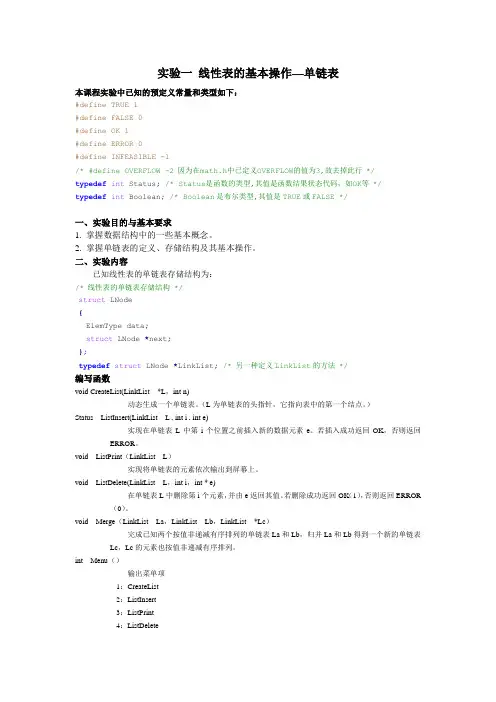
实验一线性表的基本操作—单链表本课程实验中已知的预定义常量和类型如下:#define TRUE 1#define FALSE 0#define OK 1#define ERROR 0#define INFEASIBLE -1/* #define OVERFLOW -2 因为在math.h中已定义OVERFLOW的值为3,故去掉此行 */typedef int Status;/* Status是函数的类型,其值是函数结果状态代码,如OK等 */typedef int Boolean;/* Boolean是布尔类型,其值是TRUE或FALSE */一、实验目的与基本要求1. 掌握数据结构中的一些基本概念。
2. 掌握单链表的定义、存储结构及其基本操作。
二、实验内容已知线性表的单链表存储结构为:/* 线性表的单链表存储结构 */struct LNode{ElemType data;struct LNode *next;};typedef struct LNode *LinkList;/* 另一种定义LinkList的方法 */编写函数void CreateList(LinkList *L,int n)动态生成一个单链表。
(L为单链表的头指针,它指向表中的第一个结点。
)Status ListInsert(LinkList L , int i , int e)实现在单链表L中第i个位置之前插入新的数据元素e。
若插入成功返回OK,否则返回ERROR。
void ListPrint(LinkList L)实现将单链表的元素依次输出到屏幕上。
void ListDelete(LinkList L,int i,int * e)在单链表L中删除第i个元素,并由e返回其值。
若删除成功返回OK(1),否则返回ERROR (0)。
void Merge(LinkList La,LinkList Lb,LinkList *Lc)完成已知两个按值非递减有序排列的单链表La和Lb,归并La和Lb得到一个新的单链表Lc,Lc的元素也按值非递减有序排列。
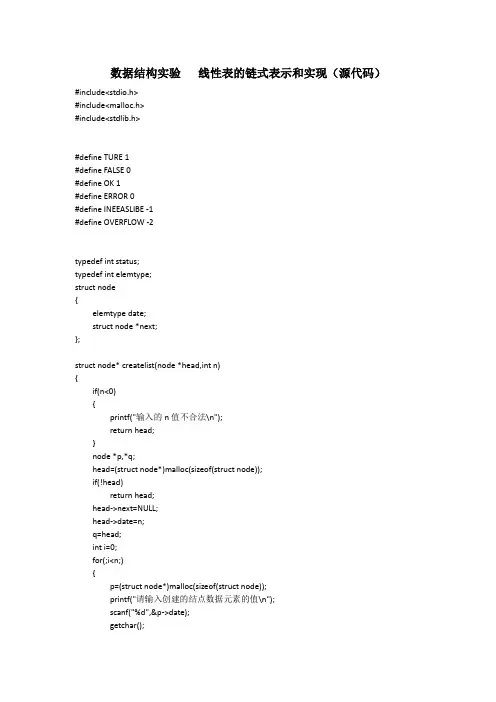

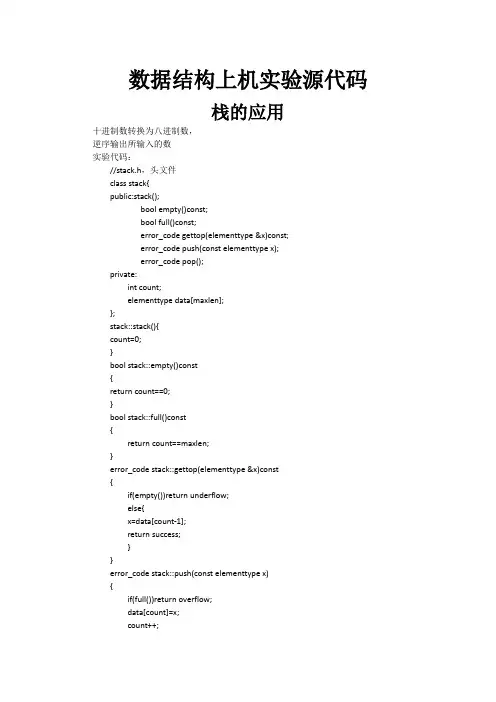
数据结构上机实验源代码栈的应用十进制数转换为八进制数,逆序输出所输入的数实验代码://stack.h,头文件class stack{public:stack();bool empty()const;bool full()const;error_code gettop(elementtype &x)const;error_code push(const elementtype x);error_code pop();private:int count;elementtype data[maxlen];};stack::stack(){count=0;}bool stack::empty()const{return count==0;}bool stack::full()const{return count==maxlen;}error_code stack::gettop(elementtype &x)const{if(empty())return underflow;else{x=data[count-1];return success;}}error_code stack::push(const elementtype x){if(full())return overflow;data[count]=x;count++;return success;}error_code stack::pop(){if(empty())return underflow;count--;return success;}//主程序#include<iostream.h>enum error_code{overflow,underflow,success};typedef int elementtype;const int maxlen=20;#include"stack.h"void read_write() //逆序输出所输入的数{stack s;int i;int n,x;cout<<"please input num int n:";cin>>n;for(i=1;i<=n;i++){cout<<"please input a num:";cin>>x;s.push(x);}while(!s.empty()){s.gettop(x);cout<<x<<" ";s.pop();}cout<<endl;}void Dec_to_Ocx(int n) //十进制转换为八进制{stack s1;int mod,x;while(n!=0){mod=n%8;s1.push(mod);n=n/8;}cout<<"the ocx of the dec is:";while(!s1.empty()){s1.gettop(x);cout<<x;s1.pop();}cout<<endl;}void main(){int n;// read_write();cout<<"please input a dec:";cin>>n;Dec_to_Ocx(n);}队列的应用打印n行杨辉三角实验代码://queue.hclass queue{public:queue(){count=0;front=rear=0;}bool empty(){return count==0;}bool full(){return count==maxlen-1;}error_code get_front(elementtype &x){if(empty())return underflow;x=data[(front+1)%maxlen];return success;}error_code append(const elementtype x){if(full())return overflow;rear=(rear+1)%maxlen;data[rear]=x;count++;return success;}error_code serve(){if(empty())return underflow;front=(front+1)%maxlen;count--;return success;}private:int count;int front;int rear;int data[maxlen];};//主程序#include<iostream.h>enum error_code{overflow,underflow,success};typedef int elementtype;const int maxlen=20;#include"queue.h"void out_number(int n) //打印前n行的杨辉三角{int s1,s2;int i;int j;int k;queue q;for(i=1;i<=(n-1)*2;i++)cout<<" ";cout<<"1 "<<endl;q.append(1);for(i=2;i<=n;i++){s1=0;for(k=1;k<=(n-i)*2;k++)cout<<" ";for(j=1;j<=i-1;j++){q.get_front(s2);q.serve();cout<<s1+s2<<" ";q.append(s1+s2);s1=s2;}cout<<"1 "<<endl;q.append(1);}}void main(){int n;cout<<"please input n:";cin>>n;out_number(n);}单链表实验实验目的:实验目的(1)理解线性表的链式存储结构。
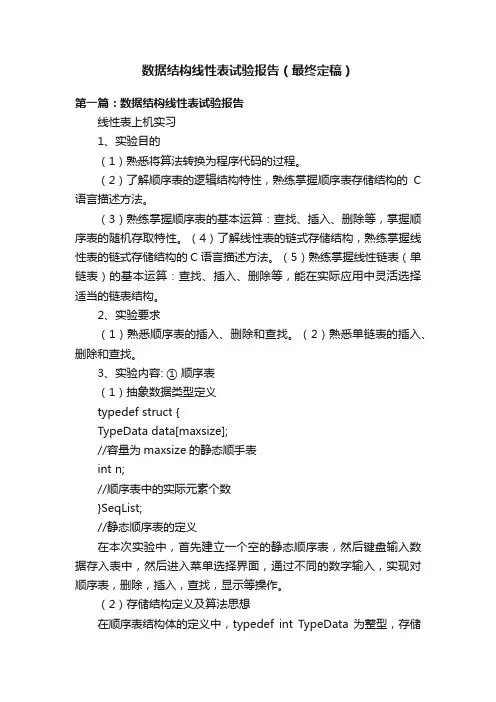
数据结构线性表试验报告(最终定稿)第一篇:数据结构线性表试验报告线性表上机实习1、实验目的(1)熟悉将算法转换为程序代码的过程。
(2)了解顺序表的逻辑结构特性,熟练掌握顺序表存储结构的C 语言描述方法。
(3)熟练掌握顺序表的基本运算:查找、插入、删除等,掌握顺序表的随机存取特性。
(4)了解线性表的链式存储结构,熟练掌握线性表的链式存储结构的C语言描述方法。
(5)熟练掌握线性链表(单链表)的基本运算:查找、插入、删除等,能在实际应用中灵活选择适当的链表结构。
2、实验要求(1)熟悉顺序表的插入、删除和查找。
(2)熟悉单链表的插入、删除和查找。
3、实验内容: ① 顺序表(1)抽象数据类型定义typedef struct {TypeData data[maxsize];//容量为maxsize的静态顺手表int n;//顺序表中的实际元素个数}SeqList;//静态顺序表的定义在本次实验中,首先建立一个空的静态顺序表,然后键盘输入数据存入表中,然后进入菜单选择界面,通过不同的数字输入,实现对顺序表,删除,插入,查找,显示等操作。
(2)存储结构定义及算法思想在顺序表结构体的定义中,typedef int TypeData 为整型,存储结构如下:for(n=0;ncout<<“请输入线性表数据”<cin>>L.data[n];//顺序将数据存入顺序表}//其他存储与此类似,都是直接赋值与数组的某一位插入版块子函数:void insert(SeqList &L)//插入数据 {int a,b,c,k;cout<<“请输入插入的数及其插入的位置”<cin>>a>>b;if(b<=0||b>(L.n+1)){cout<<“不能在该位置插入”<k=L.data[b-1];L.data[b-1]=a;c=L.n;L.n=L.n+1;while(c>b){L.data[c]=L.data[c-1];c--;//通过循环,实现插入位置后的数据挨个往后移动一位}L.data[b]=k;} 顺序表的插入与删除操作类似,在插入与删除后,都要循环调整后面数组的每一位元素,同时记录数据元素的长度的标示符也要跟着改变。
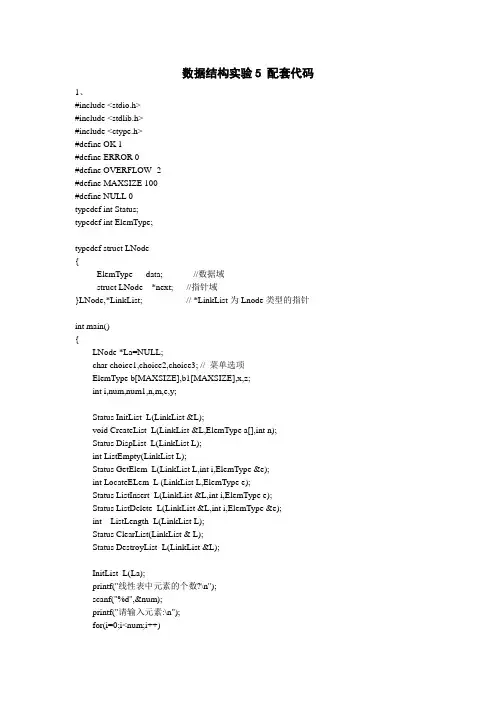
数据结构实验5 配套代码1、#include <stdio.h>#include <stdlib.h>#include <ctype.h>#define OK 1#define ERROR 0#define OVERFLOW -2#define MAXSIZE 100#define NULL 0typedef int Status;typedef int ElemType;typedef struct LNode{ElemType data; //数据域struct LNode *next; //指针域}LNode,*LinkList; // *LinkList为Lnode类型的指针int main(){LNode *La=NULL;char choice1,choice2,choice3; // 菜单选项ElemType b[MAXSIZE],b1[MAXSIZE],x,z;int i,num,num1,n,m,e,y;Status InitList_L(LinkList &L);void CreateList_L(LinkList &L,ElemType a[],int n);Status DispList_L(LinkList L);int ListEmpty(LinkList L);Status GetElem_L(LinkList L,int i,ElemType &e);int LocateELem_L (LinkList L,ElemType e);Status ListInsert_L(LinkList &L,int i,ElemType e);Status ListDelete_L(LinkList &L,int i,ElemType &e);int ListLength_L(LinkList L);Status ClearList(LinkList & L);Status DestroyList_L(LinkList &L);InitList_L(La);printf("线性表中元素的个数?\n");scanf("%d",&num);printf("请输入元素:\n");for(i=0;i<num;i++)scanf("%d",&b[i]);CreateList_L(La,b,num);do{printf("\t单链表操作\n");printf("P-输出\t\tG-取值\n");printf("S-查找\t\tI-插入\n");printf("D-删除\t\tC-清空\n");printf("L-求表长\tQ-退出\n");scanf(" %c", &choice1);choice1 = toupper(choice1); //将字符choice转换为大写英文字母switch (choice1){case 'P':printf("线性表中的元素为:\n");DispList_L(La);break;case 'G':printf("要查找第几个元素?\n");scanf("%d",&n);m=GetElem_L(La,n,e);if(!m)printf("要查找的元素位置不合法!\n");elseprintf("要查找的第%d个元素是:%d\n",n,e);break;case 'S':printf("要查找的元素的值为:\n");scanf("%d",&x);m=LocateELem_L(La,x);if(!m)printf("线性表中不存在该元素!\n");elseprintf("%d是本表中的第%d个元素。
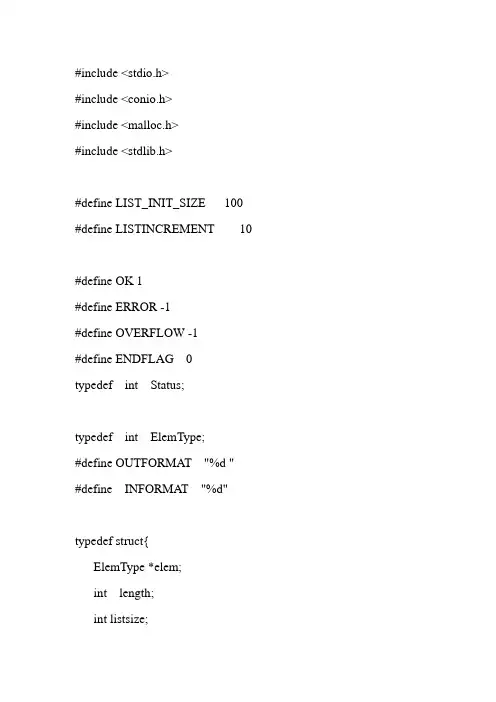
#include <stdio.h>#include <conio.h>#include <malloc.h>#include <stdlib.h>#define LIST_INIT_SIZE 100 #define LISTINCREMENT 10#define OK 1#define ERROR -1#define OVERFLOW -1#define ENDFLAG 0typedef int Status;typedef int ElemType;#define OUTFORMAT "%d "#define INFORMAT "%d"typedef struct{ElemType *elem;int length;int listsize;}SqList;Status InitList(SqList *L){L->elem=(ElemType*)malloc(LIST_INIT_SIZE*sizeof(ElemType));if(!L->elem) ////// 如果没有分配成功exit(OVERFLOW); /////退出,显示()内内容L->length=0;L->listsize=LIST_INIT_SIZE;return OK;}Status Inputdata(SqList *L){ ///////SqList *L定义首节点的地址ElemType temp,*newbase;printf("\nInput the data of the sequencial list:\nNote:0 is the ending flag:\n");scanf(INFORMAT,&temp);while(temp!=ENDFLAG){if(L->length>=L->listsize){newbase=(ElemType *)realloc(L->elem,(L->listsize+LISTINCREMENT)*sizeof(ElemType));////扩大空间,把旧的地址拷贝到新空间if(!newbase)exit(OVERFLOW);L->elem=newbase;L->listsize+=LISTINCREMENT;}L->elem[L->length++]=temp;scanf(INFORMAT,&temp);}return OK;}Status ListInsert(SqList *L,int i,ElemType e){ElemType *p,*q,*newbase;if(i<0||i>L->length)return ERROR;if(L->length>=L->listsize){Newbase =( elemType*)realloc(L->elem,(L->listsize+LISTINCREMENT)*sizeof(ElemType));if(!newbase) exit(OVERFLOW);L->elem=newbase;L->listsize+=LISTINCREMENT;}q=&(L->elem[i-1]);for(p=&(L->elem[L->length-1]);p>=q;--p)*(p+1)=*p;*q=e;++L->length;return OK;}void MyDisplay(SqList L){int i;for(i=0;i<L.length;i++)printf(OUTFORMAT,L.elem[i]);printf("\n");}void main(void){SqList L;ElemType temp;int i;if(!InitList(&L)) { ////如果初始化失败printf("To initialize the sequencial list fail\n");getch(); //////如果失败,按任意键退出exit(0);}if(!Inputdata(&L)){printf("To input the data of the sequencial list fail\n");getch();exit(0);}MyDisplay(L);printf("Input the data that you want to insert:");scanf(INFORMAT,&temp);printf("Input the insert_location:");scanf("%d",&i);if(!ListInsert(&L,i,temp)){printf("To insert fail\n");getch();exit(0);}MyDisplay(L);getch();}。
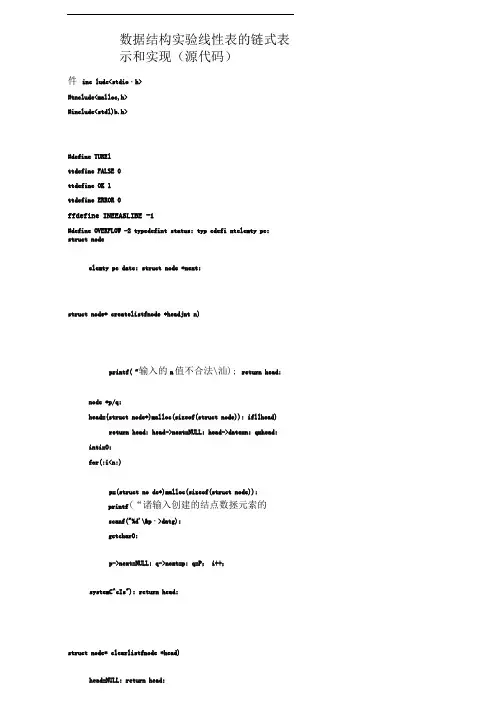
数据结构实验线性表的链式表示和实现(源代码)件inc lude<stdio・h>#tnclude<malloc,h>#include<stdl)b.h>#define TURElttdefine FALSE 0ttdefine OK 1ttdefine ERROR 0ffdefine INEEASLIBE -1#define OVERFLOW -2 typedefint status; typ edefi ntelemty pe; struct nodeelemty pe date; struct node *next;struct node* createlistfnode *headjnt n)printf(“输入的n值不合法\汕); return head;node *p/q;head={struct node*)malloc(sizeof(struct node)); ifllhead) return head; head->next=NULL; head->date=n; q=head;inti=O;for(;i<n;)p=(struct no de*)malloc(sizeof(struct node));printf(“诸输入创建的结点数拯元索的scanf("%d'\&p・>datg);getcharO;p->next=NULL; q->next=p; q=P; i++;systemC^cIs"); return head;struct node* clearlistfnode *head)head=NULL; return head;status destroylist(node *head)head=NULL; free(head); return OK; statuslistempty(node *head)if|head==NULL)return OK;elsereturn ERROR;statusiist!ength(node *head)inti=0; node *p;p=head->next; while ⑴i++; if(p->next==NULL) break;p=p->next;prints该线性表的表长为%d\n\i);return OK;statusgetelem(node *headjnti,elemtype&e)node *p; p=head-> next; int n=1;printfC输入的i傅不合法\屮); return ERROR;while(n<i)p=p・> next;n++;iflp==NULL)printT输入的i值不合法W); return ERROR;e=p->date; return OK;statuslocatelemfnode *head,elemtvpe e)node *p; inti=l; p=head->next; while ⑴if(p->date==e&&p==NULL) break;p=p->next;i++;if)p==NULL)prints该线性表中没有%d这个数据元索\吧6);return ERROR;printfC-%d存在该线性表的第%d位\叭巳i); return OK; statuspnorelem(node *headjntbelemtype&e)printfC该位上的数据元素为一个元索没有直接前驱元^\nj; return ERROR;struct node *p/q; p=head->next;int j=l;for(;p!=NULL;p=p->next)break;q=p;j++; iflp!=NULL)e*q・>date;printf(“该元索有数据元素并且直接前驱元索已传递给0\""); returnOK;elseprintfC输入的i值不合法\门”); return ERROR;statusnextelem(node *head,inti,elenritype&e) struct node *p; p=head->next;int j=O;for(;p->next!=NULL; p=p->next)j++;break;iflp->next!=NULL)e=p・> next->date;printf(“该位上有后继元索且K接后继元索的垃已传递给e\n“);return OK;if(p->next==:NULL&&(j+l)Ki)prints该位上的数据元素为最后一个元素没有直接后继元素Vn; returnERROR;else if(p==NULL&&{j+l)<i)printT输入的i值不合法W); return ERROR;struct node* insert(node *headjnti,elemtype e)printfC输入的i值不合法\门”); return head;struct node *q/p;q=head;int j=l;p=(struct no de*)malloc(sizeof(struct n ode)); p ・>date=e;while(j<i)if(q・>next==NULL) break;q=q->next; j++;p・> next=q->next; q・>next=p;elseprints输入的i值不合法\小;return head;struct node* delete_node{node *head,inti,elemtype&e)printf(”输入的i值不合法W); return head;struct node *p,*q; p 二head;int j=l; while(j<i)if(p・> next->next==NULL) break;p=p・> next;j++;q=p・>n ext;p ・>next=p・> next->next;e=q->date;free(q);ifijd)printfr输入的i值不合法\叶1;return head;status trip(node *head)struct node *p; p=head->next; inti=l;doprintf("第%d 位=~%d\n'\i,p*>datG); p=p・> next;i++;}vzhile(p!=NULL);return OK;main()struct node *head; char a,int n; elemty pe e; while(l)printfCl:构造一个线性後\"2:销毁线性表\n3:将已有线性表置为空表\"4:判断线性衣是否为空\n5:计算已有线性表中数据元素的个数\n”);printfC'6:取出元索的值\n7:定位元索的位置\n8:插入新的数据元索\n9:删除某一个数据元索\冋显示该线性表中全部的元索W);printfC'b:取出特定位置的貞接前驱元素\皿:取出特定位置上直接后继元素00:退出\n\n\n'*);scanf("%c'\&a);getcharO;systemCcIs”);switch(a)case O: exit(O);case T:printf("请输入需要创建元索的个数n\n"); scanf(” %d”,&n);getcharO;head=createlist(head,n); break;case 2:if(destroylist{head)==OK)head=NULL;free(head);prints线性表销毁成功\");break;case 3:clearlist(head);printf(“线性表以置为空表\""); break;case '4':if(listempty(head)==OK) phntfC*线性表为空表\n“); elsephntfC'线性表不为空表匕“);break;case S:listlength(head);break;case '6':Printf(“请输入需要取出元素的位数冲“);scanf(”%cr:&n);getcharO;P rintf("\n");getelem(head,n,e);printf("第%d位数据元索的值为%d\n'\n,e); break;case 7:p hntfC'W输入需要定位元素的值e=");scanfC'%d\&€);getcharO;P rintfCAn-);locatelem(head,e);break;case 8:printf(”请输入需要插入的位置n=");scanf(”%cr:&n);getcharO;printfCAn该位置上的数据元素的值曰);scanf(-%cl\&e); getcharO;p hntf("\n");head=insert(head, n^e);break;case 9:Printf(“诸输入需要删除的位置n=-); scanfr%cr&n); getcharO;delGte_node(head,n,G);printf(" C•删除第%(1位上的数据元素%d\n",n,e); break;case N:tnp(head);break;case V:phntfC'i#输入需要取出直接前驱元素的位数n=**); scanfC'% cT&n);getcharO;if(p norelem(head,n,e)==OK)printf("\n第%€1位的直接前驱元素为%d\n'\n,e); break;case 'c';pmtf(“诸输入需要取出克接后继元素的位数冲“); scanf("%d'\&n);getcharO;if(nextelem(head,n,e)==OK)printf("\n第%<1位的直接后继元索为%d\n'\n,e); break;default:printf(”输入不合法 ... 请选择:\n'");printf("\n\n\n'');。
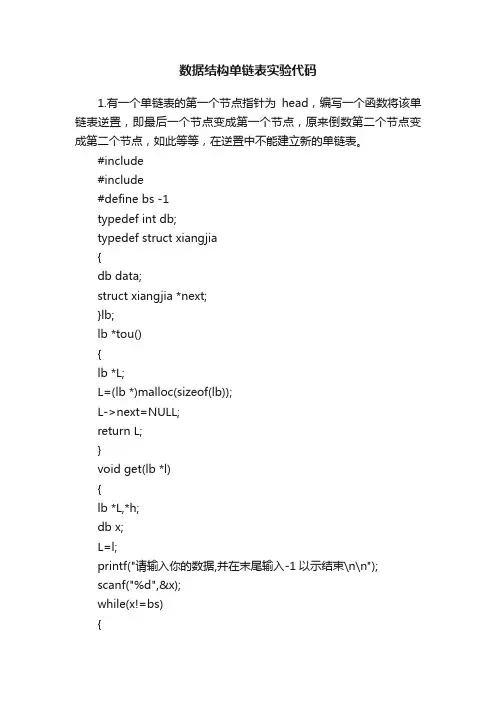
数据结构单链表实验代码1.有一个单链表的第一个节点指针为head,编写一个函数将该单链表逆置,即最后一个节点变成第一个节点,原来倒数第二个节点变成第二个节点,如此等等,在逆置中不能建立新的单链表。
#include#include#define bs -1typedef int db;typedef struct xiangjia{db data;struct xiangjia *next;}lb;lb *tou(){lb *L;L=(lb *)malloc(sizeof(lb));L->next=NULL;return L;}void get(lb *l){lb *L,*h;db x;L=l;printf("请输入你的数据,并在末尾输入-1以示结束\n\n");scanf("%d",&x);while(x!=bs){h=(lb *)malloc(sizeof(lb)); h->data=x;h->next=L->next;L->next=h;scanf("%d",&x);}}void put(lb *l){lb *L;L=l;printf("链表中的数据有:\n"); while(L->next!=NULL) {printf("%d",L->next->data); L=L->next;if(L->next!=NULL){printf("->");}}printf("\n");}main(){lb *a;a=tou();get(a);printf("逆序后的整数表:"); put(a);}2.编写程序,将若干整数从键盘输入,以单链表形式存储起来,然后计算单链表中结点的个数(其中指针P指向该链表的第一个结点)。
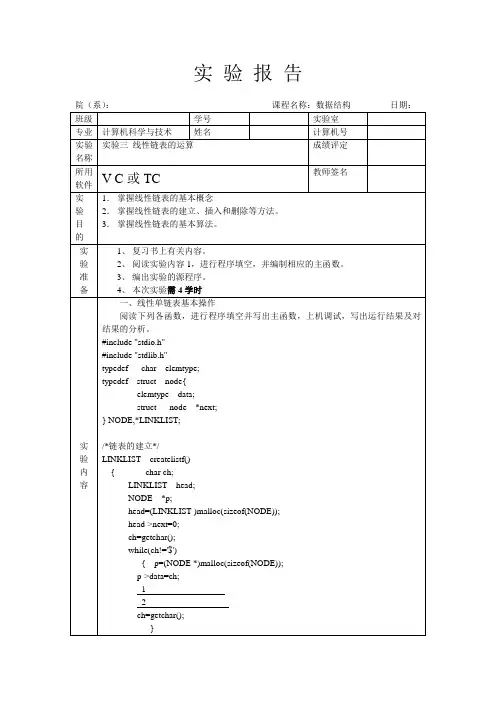
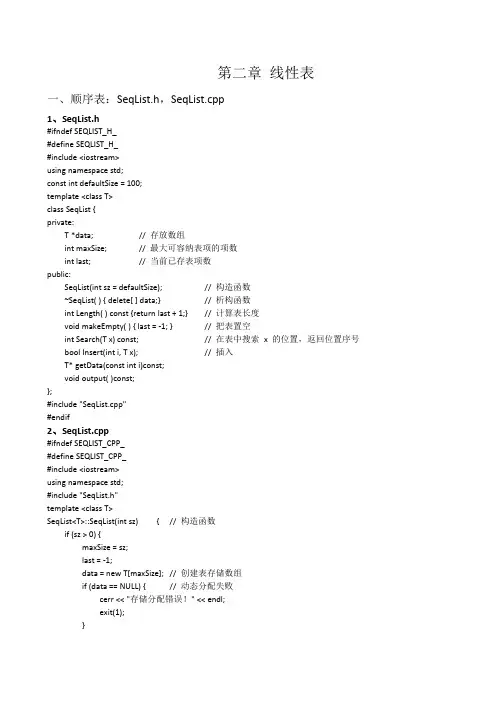
#include <stdio.h>#include <stdlib.h>#include<conio.h>struct SQList{int elem[100];int len;} ;SQList creat_SQList()//创建一个线性表{SQList l;int i=0;printf("请输入顺序表");scanf("%d",&l.elem[i]);while(l.elem[i]!=0){i++;scanf("%d",&l.elem[i]);}l.len=i;return l;}void print_SQList(SQList l)//顺序表输出{int i;printf("顺序表中的元素是:\n");for(i=0;i<l.len;i++){printf("%3d",l.elem[i]);}printf("\n");}SQList Merge_SQList(SQList LA,SQList LB,SQList LC)//顺序表合并{int i=0;int j=0;int k=0;while(i<LA.len&&j<LB.len){ if(LA.elem[i]<=LB.elem[j]){LC.elem[k++]=LA.elem[i];i++;}else {LC.elem[k++]=LB.elem[j];j++;}}while(i<LA.len){LC.elem[k++]=LA.elem[i++];}while(j<LB.len){LC.elem[k++]=LB.elem[j++];}LC.len=LA.len+LB.len;return (LC);}SQList SQList_insert(SQList s,int i,int x)//插入一个元素{int j;if(i<0||i>s.len)printf("插入位置不存在");else{for(j=s.len;j>=i;j--)s.elem[j+1]=s.elem[j];s.elem[i]=x;s.len=s.len+1;}//print_SQList(s);return s;}SQList SQList_delete(SQList s,int i)//删除元素{int j;if(i<0||i>s.len)printf("i位置不存在");else{for(j=i;j<s.len;j++)s.elem[j]=s.elem[j+1];s.len--;}//print_SQList(s);return s;}void main()//主菜单{SQList LA,LB,LC;int i,y,cord;//clrsor();do{printf("\n 主菜单\n");printf("1 建立线性表\n");printf("2 插入一个元素\n");printf("3 删除一个元素\n");printf("4 合并线性表\n");printf("5 退出\n");printf("-----------------------\n");printf("请输入你的选择(1,2,3,4,5)");scanf("%d",&cord);switch(cord){case 1:{LA=creat_SQList();LB=creat_SQList();printf("list LA:");print_SQList(LA);printf("list LB:");print_SQList(LB);}break;case 2:{printf("请输入插入位置及元素:");scanf("%d,%d",&i,&y);LA=SQList_insert(LA,i,y);printf("list LA");print_SQList(LA);}break;case 3:{printf("请输入删除位置");scanf("%d",&i);LA=SQList_delete(LA,i);printf("list LA");print_SQList(LA);}break;case 4:{printf("线性表合并:");LC=Merge_SQList(LA,LB,LC);printf("list LC");print_SQList(LC);}break;case 5: exit(0);}}while(cord<=5); }。
#include<stdio.h>#include<malloc.h>#define OK 1#define ERROR 0#define LIST_INIT_SIZE 100#define LISTINCREMENT 10#define ElemType inttypedef struct{int *elem,length,listsize;}SqList;int InitList_Sq(SqList &L){L.elem=(ElemType*)malloc(LIST_INIT_SIZE*sizeof(ElemType));L.length=0;L.listsize=LIST_INIT_SIZE;return OK;}int Load_Sq(SqList &L){int i;if(L.length==0)printf("The List is empty!");else{printf("The List is:");for(i=0;i<L.length;i++)printf("% d",L.elem[i]);}printf("\n");return OK;}int ListInsert_Sq(SqList &L,int i,int e){if(i<1||i>L.length+1)return ERROR;ElemType *newbase,*q,*p;if(L.length>=L.listsize){newbase=(ElemType*)realloc(L.elem,(L.listsize+LISTINCREMENT)*sizeof(ElemType));L.elem=newbase;L.listsize+=LISTINCREMENT;}q=&(L.elem[i-1]);for(p=&(L.elem[L.length-1]);p>=q;--p)*(p+1)=*p;*q=e;++L.length;return OK;}int ListDelete_Sq(SqList &L,int i,int &e){ElemType *q,*p;if(i<1||i>L.length)return ERROR;p=&(L.elem[i-1]);e=*p;q=L.elem+L.length-1;for(++p;p<=q;p++)*(p-1)=*p;L.length--;return OK;}int main(){SqList T;int a,i;ElemType e,x;if(InitList_Sq(T)){printf("A Sequence List Has Created.\n");}while(1){printf("1:Insert element\n2:Delete element\n3:Load all elements\n0:Exit\nPlease choose:\n");scanf("%d",&a);switch(a){case 1: scanf("%d%d",&i,&x);if(!ListInsert_Sq(T,i,x))printf("Insert Error!\n");elseprintf("The Element %d is Successfully Inserted!\n",x);break;case 2: scanf("%d",&i);if(!ListDelete_Sq(T,i,e))printf("Delete Error!\n");elseprintf("The Element %d is Successfully Deleted!\n",e);break;case 3: Load_Sq(T);break;case 0: return 1;}}}222222222222222222222222222222222222222222222222222222222222222222222222222222 #include<stdio.h>#include<malloc.h>#define OK 1#define ERROR 0#define LIST_INIT_SIZE 100#define LISTINCREMENT 10#define ElemType inttypedef struct{int *elem,length,listsize;}SqList;int InitList_Sq(SqList &L){L.elem=(ElemType*)malloc(LIST_INIT_SIZE*sizeof(ElemType));L.length=0;L.listsize=LIST_INIT_SIZE;return OK;}int Load_Sq(SqList &L){int i;for(i=0;i<L.length;i++)printf("%d ",L.elem[i]);printf("\n");return OK;}int ListLength(SqList L){return L.length;}int GetElem(SqList L,int i,ElemType &e){e=L.elem[i-1];return OK;}int ListInsert_Sq(SqList &L,int i,int e){if(i<1||i>L.length+1)return ERROR;ElemType *p,*q,*newbase;if(L.listsize<=L.length){newbase=(ElemType*)realloc(L.elem,(L.listsize+LISTINCREMENT)*sizeof(ElemType));L.elem=newbase;L.listsize+=LISTINCREMENT;}q=&(L.elem[i-1]);for(p=&(L.elem[L.length-1]);p>=q;p--)*(p+1)=*p;*q=e;L.length++;return OK;}void MergeList(SqList La,SqList Lb,SqList &Lc){int i,j,k,La_len,Lb_len,ai,bj;i=j=1;k=0;InitList_Sq(Lc);La_len=ListLength(La);Lb_len=ListLength(Lb);while((i<=La_len)&&(j<=Lb_len)){GetElem(La,i,ai);GetElem(Lb,j,bj);if(ai<=bj){ListInsert_Sq(Lc,++k,ai);i++;}else{ListInsert_Sq(Lc,++k,bj);j++;}}while(i<=La_len){GetElem(La,i++,ai);ListInsert_Sq(Lc,++k,ai);}while(j<=Lb_len){GetElem(Lb,j++,bj);ListInsert_Sq(Lc,++k,bj);}Load_Sq(Lc);}int main(){int an,bn,i,e;SqList La,Lb,Lc;InitList_Sq(La);scanf("%d",&an);for(i=1;i<=an;i++){scanf("%d",&e);ListInsert_Sq(La,i,e);}printf("List A:");Load_Sq(La);InitList_Sq(Lb);scanf("%d",&bn);for(i=1;i<=an;i++){scanf("%d",&e);ListInsert_Sq(Lb,i,e);}printf("List B:");Load_Sq(Lb);printf("List C:");MergeList(La,Lb,Lc);return 0;}333333333333333333333333333333333333333333333333333333333333333333333333333333 #include<stdio.h>#include<malloc.h>#define OK 1#define ERROR 0#define LIST_INIT_SIZE 100#define LISTINCREMENT 10#define ElemType inttypedef struct{int *elem,length,listsize;}SqList;int InitList_Sq(SqList &L){L.elem=(ElemType*)malloc(LIST_INIT_SIZE*sizeof(ElemType));if(!L.elem){printf("NO1");return ERROR;}L.length=0;L.listsize=LIST_INIT_SIZE;return OK;}int Load_Sq(SqList &L){int i;if(!L.length){printf("This List is empty!\n");return ERROR;}else{for(i=0;i<L.length;i++)printf("%d ",L.elem[i]);}printf("\n");return OK;}int ListInsert_Sq(SqList &L,int i,int e){ElemType *newbase,*p,*q;if(L.length>=L.listsize){newbase=(ElemType*)realloc(L.elem,(L.listsize+LISTINCREMENT)*sizeof(ElemType));if(!newbase){printf("NO2");return ERROR;}L.elem=newbase;L.listsize+=LISTINCREMENT;}q=&(L.elem[i-1]);for(p=&(L.elem[L.length-1]);p>=q;p--)*(p+1)=*p;*q=e;L.length++;return OK;}int swap(SqList &L,int n){int i,j,temp;for(i=0,j=n-1;j>i;i++,j--){temp=L.elem[i];L.elem[i]=L.elem[j];L.elem[j]=temp;}return OK;}int main(){SqList T;int n,i;ElemType x;scanf("%d",&n);InitList_Sq(T);for(i=1;i<n+1;i++){scanf("%d",&x);ListInsert_Sq(T,i,x);}printf("The List is:");Load_Sq(T);swap(T,n);printf("The turned List is:");Load_Sq(T);return 0;}444444444444444444444444444444444444444444444444444444444444444444444444444444 #include<stdio.h>#include<malloc.h>#define ERROR 0#define OK 1#define ElemType inttypedef struct LNode{int data;struct LNode *next;}LNode,*LinkList;int CreateLink_L(LinkList &L,int n){LinkList p,q;int i;ElemType e;L=(LinkList)malloc(sizeof(LNode));L->next=NULL;q=(LinkList)malloc(sizeof(LNode));q=L;for(i=0;i<n;i++){scanf("%d",&e);p=(LinkList)malloc(sizeof(LNode));p->data=e;p->next=q->next;q->next=p;q=q->next;}return OK;}int LoadLink_L(LinkList &L){LinkList p=L->next;if(!p)printf("The List is empty!");else{printf("The LinkList is:");while(p){printf("%d ",p->data);p=p->next;}}printf("\n");return OK;}int LinkInsert_L(LinkList &L,int i,ElemType e) {LNode *p=L,*s;int j=0;while(p&&j<i-1){p=p->next;j++;}if(!p||j>i-1)return ERROR;s=(LinkList)malloc(sizeof(LNode));s->data=e;s->next=p->next;p->next=s;return OK;}int LinkDelete_L(LinkList &L,int i,ElemType &e) {LNode *p=L,*q;int j=0;while(p->next&&j<i-1){p=p->next;j++;}if(!(p->next)||j<i-1)return ERROR;q=p->next;p->next=q->next;e=q->data;free(q);return OK;}int main(){LinkList T;int a,n,i;ElemType x,e;printf("Please input the init size of the linklist:\n");scanf("%d",&n);printf("Please input the %d element of the linklist:\n",n);if(CreateLink_L(T,n)){printf("A Link List Has Created.\n");LoadLink_L(T);}while(1){printf("1:Insert element\n2:Delete element\n3:Load all elements\n0:Exit\nPlease choose:\n");scanf("%d",&a);switch(a){case 1:scanf("%d%d",&i,&x);if(!LinkInsert_L(T,i,x))printf("Insert Error!\n");elseprintf("The Element %d is Successfully Inserted!\n",x);break;case 2:scanf("%d",&i);if(!LinkDelete_L(T,i,e))printf("Delete Error!\n");elseprintf("The Element %d is Successfully Deleted!\n",e);break;case 3:LoadLink_L(T);break;case 0:return 1;}}}555555555555555555555555555555555555555555555555555555555555555555555555555555 #include<stdio.h>#include<malloc.h>#define ERROR 0#define OK 1#define ElemType inttypedef struct LNode{int data;struct LNode *next;}LNode,*LinkList;int CreateLink_L(LinkList &L,int n){LinkList p,q;int i;ElemType e;L=(LinkList)malloc(sizeof(LNode));L->next=NULL;q=(LinkList)malloc(sizeof(LNode));q=L;for(i=0;i<n;i++){scanf("%d",&e);p=(LinkList)malloc(sizeof(LNode));p->data=e;p->next=q->next;q->next=p;q=q->next;}return OK;}int LoadLink_L(LinkList &L){LinkList p=L->next;if(!p)printf("The List is empty!");else{while(p){printf("%d ",p->data);p=p->next;}}printf("\n");return OK;}void MergeList_L(LinkList &La,LinkList &Lb,LinkList &Lc) {LinkList pa,pb,pc;pa=La->next;pb=Lb->next;Lc=pc=La;while(pa&&pb){if(pa->data<=pb->data){pc->next=pa;pc=pa;pa=pa->next;}else{pc->next=pb;pc=pb;pb=pb->next;}}pc->next=pa?pa:pb;free(Lb);}int main(){LinkList La,Lb,Lc;int n;scanf("%d",&n);CreateLink_L(La,n);printf("List A:");LoadLink_L(La);scanf("%d",&n);CreateLink_L(Lb,n);printf("List B:");LoadLink_L(Lb);MergeList_L(La,Lb,Lc);printf("List C:");LoadLink_L(Lc);return 0;}。
数据结构实验报告实验名称:实验一——线性表学生姓名:SECRET班级:SECRET班内序号:SECRET学号:SECRET日期:2050年5月20日1.实验要求根据线性表的抽象数据类型的定义,选择下面任一种链式结构实现线性表,并完成线性表的基本功能。
线性表存储结构(五选一):1、带头结点的单链表2、不带头结点的单链表3、循环链表4、双链表5、静态链表线性表的基本功能:1、构造:使用头插法、尾插法两种方法2、插入:要求建立的链表按照关键字从小到大有序3、删除4、查找5、获取链表长度6、销毁7、其他:可自行定义编写测试main()函数测试线性表的正确性。
2. 程序分析2.1 存储结构2.2 关键算法分析关键算法1:头插法自然语言描述:a:在堆中建立新结点b:将a[i]写入到新结点的数据域c:修改新结点的指针域d:修改头结点的指针域。
将新结点加入链表中伪代码描述a:Node <T> * s=new Node <T>b:s->data=a[i]c:s->next=front->next;d:front->next=s2:尾插法自然语言描述:a:在堆中建立新结点:b:将a[i]写入到新结点的数据域:c:将新结点加入到链表中d:修改修改尾指针伪代码描述a:Node <T> * s=new Node <T>b:s->data=a[i]c:r->next=s;d:r=s3:析构/删除函数自然语言描述:a:新建立一个指针,指向头结点b:判断要释放的结点是否存在,c:暂时保存要释放的结点d:移动a 中建立的指针e:释放要释放的指针伪代码描述a:Node <T> * p=frontb:while(p)c: front=pd:p=p->nexte:delete front4:按位查找函数自然语言描述:a:初始化工作指针p 和计数器j,p 指向第一个结点,j=1b:循环以下操作,直到p 为空或者j 等于1b1:p 指向下一个结点b2:j 加1c:若p 为空,说明第i 个元素不存在,抛出异常d:否则,说明p 指向的元素就是所查找的元素,返回元素地址伪代码描述a:Node <T> * p=front->next;j=1;b:while(p&&j!=1)b1:p=p->nextb2:j++c:if(!p) throw ”error”d:return p5:按位查找函数自然语言描述:a:初始化工作指针p 和计数器j,p 指向第一个结点,j=1b:循环以下操作,找到这个元素或者p 指向最后一个结点b1:判断p 指向的结点是不是要查找的值,如果是,返回j,否则p 指向下一个结点,并且j 的值加一c:如果找到最后一个结点还没有找到要查找的元素,返回查找失败信息伪代码描述a:Node <T> * p=front->next;j=1;b:while(p)b1:if(p->next==x) return jp=p->nextj++c:return “error”6:插入函数自然语言描述:a:在堆中建立新结点b:将要插入的结点的数据写入到新结点的数据域c:修改新结点的指针域d:修改前一个指针的指针域,使其指向新插入的结点的位置伪代码描述a:Node <T> * s=new Node <T>;b:s-data=p->datac:s->next=p->nextd:p->next=se:p->data=x7:删除函数自然语言描述:a:从第一个结点开始,查找要删除的位数i 前一个位置i-1 的结点b:设q 指向第i 个元素c:将q 元素从链表中删除d:保存q 元素的数据e:释放q 元素伪代码描述a:q=p->nextb:p->next=q->nextc:x=q->datad:delete q8:遍历打印函数自然语言描述:a:判断该链表是否为空链表,如果是,报错b:如果不是空链表,新建立一个temp 指针c:将temp 指针指向头结点d:打印temp 指针的data 域e:逐个往后移动temp 指针,直到temp 指针的指向的指针的next 域为空伪代码描述If front->next==NULLThrow ”an empty list ”Node<T>* temp=front->next;while(temp->next){cout<<temp->data<<" ";temp=temp->next;}9:获取链表长度函数自然语言描述:a:判断该链表是否为空链表,如果是,输出长度0b:如果不是空链表,新建立一个temp 指针,初始化整形数n 为0c:将temp 指针指向头结点d:判断temp 指针指向的结点的next 域是否为空,如果不是,n 加一,否则return ne: 使temp 指针逐个后移,重复d 操作,直到temp 指针指向的结点的next 域为0,返回n伪代码描述int n=0if front->next==NULLn=0else{Node<T>* temp=front->next;while(temp->next)n++;temp=temp->next;}return n;二代码详细分析1:头插法插入链表四句关键代码Node <T> *s =new Node <T>;s->data=a[i];s->next=front->next;front->next=s;return n;示意图2:尾插法插入链表四句关键代码Node<T> *s=new Node <T>; s->data=a[i];r->next=s;r=s;示意图3:查找算法四句关键代码Node<T>*p=front->next;int j=1;while(p&&j!=i){p=p->next;j++;}示意图4:删除算法关键代码Node<T>*p=front;if(i!=1)p=Get(i-1);Node<T>*q=p->next;p->next=q->next;T x=q->data;delete q;示意图关键算法的时间、空间复杂度头插法/尾插法O(n)按位查找/按值查找O(n)插入操作O(n)3. 程序运行结果流程图4. 总结1、调试时出现的问题及解决的方法在编写按值查找函数时,由于没有处理好指针类型的原因,导致指针无法正常返回,屡屡报错。
数据结构实验报告-实验⼀顺序表、单链表基本操作的实现实验⼀顺序表、单链表基本操作的实现l 实验⽬的1、顺序表(1)掌握线性表的基本运算。
(2)掌握顺序存储的概念,学会对顺序存储数据结构进⾏操作。
(3)加深对顺序存储数据结构的理解,逐步培养解决实际问题的编程能⼒。
l 实验内容1、顺序表1、编写线性表基本操作函数:(1)InitList(LIST *L,int ms)初始化线性表;(2)InsertList(LIST *L,int item,int rc)向线性表的指定位置插⼊元素;(3)DeleteList1(LIST *L,int item)删除指定元素值的线性表记录;(4)DeleteList2(LIST *L,int rc)删除指定位置的线性表记录;(5)FindList(LIST *L,int item)查找线性表的元素;(6)OutputList(LIST *L)输出线性表元素;2、调⽤上述函数实现下列操作:(1)初始化线性表;(2)调⽤插⼊函数建⽴⼀个线性表;(3)在线性表中寻找指定的元素;(4)在线性表中删除指定值的元素;(5)在线性表中删除指定位置的元素;(6)遍历并输出线性表;l 实验结果1、顺序表(1)流程图(2)程序运⾏主要结果截图(3)程序源代码#include<stdio.h>#include<stdlib.h>#include<malloc.h>struct LinearList/*定义线性表结构*/{int *list; /*存线性表元素*/int size; /*存线性表长度*/int Maxsize; /*存list数组元素的个数*/};typedef struct LinearList LIST;void InitList(LIST *L,int ms)/*初始化线性表*/{if((L->list=(int*)malloc(ms*sizeof(int)))==NULL){printf("内存申请错误");exit(1);}L->size=0;L->Maxsize=ms;}int InsertList(LIST *L,int item,int rc)/*item记录值;rc插⼊位置*/ {int i;if(L->size==L->Maxsize)/*线性表已满*/return -1;if(rc<0)rc=0;if(rc>L->size)rc=L->size;for(i=L->size-1;i>=rc;i--)/*将线性表元素后移*/L->list[i+=1]=L->list[i];L->list[rc]=item;L->size++;return0;}void OutputList(LIST *L)/*输出线性表元素*/{int i;printf("%d",L->list[i]);printf("\n");}int FindList(LIST *L,int item)/*查找线性元素,返回值>=0为元素的位置,返回-1为没找到*/ {int i;for(i=0;i<L->size;i++)if(item==L->list[i])return i;return -1;}int DeleteList1(LIST *L,int item)/*删除指定元素值得线性表记录,返回值为>=0为删除成功*/ {int i,n;for(i=0;i<L->size;i++)if(item==L->list[i])break;if(i<L->size){for(n=i;n<L->size-1;n++)L->list[n]=L->list[n+1];L->size--;return i;}return -1;}int DeleteList2(LIST *L,int rc)/*删除指定位置的线性表记录*/{int i,n;if(rc<0||rc>=L->size)return -1;for(n=rc;n<L->size-1;n++)L->list[n]=L->list[n+1];L->size--;return0;}int main(){LIST LL;int i,r;printf("list addr=%p\tsize=%d\tMaxsize=%d\n",LL.list,LL.size,LL.Maxsize);printf("list addr=%p\tsize=%d\tMaxsize=%d\n",LL.list,LL.list,LL.Maxsize);while(1){printf("请输⼊元素值,输⼊0结束插⼊操作:");fflush(stdin);/*清空标准输⼊缓冲区*/scanf("%d",&i);if(i==0)break;printf("请输⼊插⼊位置:");scanf("%d",&r);InsertList(&LL,i,r-1);printf("线性表为:");OutputList(&LL);}while(1){printf("请输⼊查找元素值,输⼊0结束查找操作:");fflush(stdin);/*清空标准输⼊缓冲区*/scanf("%d ",&i);if(i==0)break;r=FindList(&LL,i);if(r<0)printf("没有找到\n");elseprintf("有符合条件的元素,位置为:%d\n",r+1);}while(1){printf("请输⼊删除元素值,输⼊0结束查找操作:");fflush(stdin);/*清楚标准缓存区*/scanf("%d",&i);if(i==0)break;r=DeleteList1(&LL,i);if(i<0)printf("没有找到\n");else{printf("有符合条件的元素,位置为:%d\n线性表为:",r+1);OutputList(&LL);}while(1){printf("请输⼊删除元素位置,输⼊0结束查找操作:");fflush(stdin);/*清楚标准输⼊缓冲区*/scanf("%d",&r);if(r==0)break;i=DeleteList2(&LL,r-1);if(i<0)printf("位置越界\n");else{printf("线性表为:");OutputList(&LL);}}}链表基本操作l 实验⽬的2、链表(1)掌握链表的概念,学会对链表进⾏操作。
数据结构实验二:单链表的基本操作数据结构实验二:单链表的基本操作实验二:单链表的基本操作一、【实验目的】1、理解和掌握单链表的类型定义方法和结点生成方法。
2、掌握建立单链表和显示单链表元素的算法。
3、掌握单链表的查找、插入和删除算法二、【实验内容】1、建立一个整形数的单链表,手动输入10个数,并从屏幕显示单链表元素列表。
2、从键盘输入一个数,查找在以上创建的单链表中是否存在该数;如果存在,显示它的位置;如果不存在,给出相应提示。
3、删除上述单链表中指定位置的元素。
以下就是程序部分代码,恳请调试并补足并使之恰当运转:1.linlist.htypedefstructnode{datatypedata;structnode*next;}slnode;voidlistinitiate(slnode**head)/*初始化*/{/*如果有内存空间,申请头结点空间并使头指针head指向头结点*/if((*head=(slnode*)malloc(sizeof(slnode)))==null)exit(1);(*head)->next=null;/*置链尾标记null*/}intlistlength(slnode*head){slnode*p=head;/*p指向首元结点*/intsize=0;/*size初始为0*/while(p->next!=null)/*循环计数*/{p=p->next;size++;}returnsize;}intlistinsert(slnode*head,inti,datatypex)/*在带头结点的单链表head的数据元素ai(0≤i≤size)结点前*//*填入一个存放数据元素x的结点*/{slnode*p,*q;intj;p=head;/*p指向首元结点*/j=-1;/*j起始为-1*/while(p->next!=null&&j<i-1)/*最终让指针p指向数据元素ai-1结点*/{p=p->next;j++;}if(j!=i-1){printf(\填入边线参数弄错!\return0;}/*生成新结点由指针q指示*/if((q=(slnode*)malloc(sizeof(slnode)))==null)exit(1);q->data=x;q->next=p->next;/*给指针q->next赋值*/p->next=q;/*给指针p->next重新赋值*/return1;}intlistdelete(slnode*head,inti,datatype*x)/*删除带头结点的单链表head的数据元素ai(0≤i≤size-1)结点*//*删除结点的数据元素域值由x带回。
#include<iostream.h>
template <class T>
class LinearList
{
public:
virtual bool IsEmpty()const=0;
virtual int Length()const=0;
virtual bool Find(int i,T& x)const=0;
virtual int Search(T x)const=0;
virtual bool Insert(int i,T x)=0;
virtual bool Update(int i,T x)=0;
virtual bool Delete(int i)=0;
virtual void Output(ostream& out)const=0;
protected:
int n;
};
#include "linearlist"
template <class T>
class SeqList:public LinearLisr<T>
{
public:
SeqList(int mSize);
~SeqList(){delete [] elements;}
bool IsEmpty()const;
bool Find(int i,T& x)const;
int Length()const;
int Search(T x)const;
bool Insert(int i,T x);
bool Update(int i,T x);
bool Delete(int i);
void Output(ostream& out)const;
private:
int maxLength;
T *elements;
};
template <class T>
SeqList<T>::SeqList(int mSize)
{
maxLength=mSize;
elements=new T[maxLength];
n=0;
}
template <class T>
bool SeqList<T>::IsEmpty()const
{
return n==0;
}
template <class T>
int SeqList::Length()const
{
return 0;
}
template <class T>
bool SeqList<T>::Find(int i,T& x)const
{
if(i<0||i>n-1)
{
cont<<"Out of Bounds"<<endl;
return false;
}
x=elements[i];
return true;
}
template <class T>
int SeqList<T>::Search(T x)const
{
for(int j=0;j<n;j++)
if(elements[j]==x)
return -1;
}
template <class T>
bool SeqList<T>::Insert(int i,T x)
{
if(i<-1||i>n-1)
{
cout<<"OUt of Bounds"<<endl;return false;
}
if(n==maxLength){
cout<<"OverFlow"<<endl;
return false;
}
for(int j=n-1;j>i;j--)
elements[j+1]=elements[j];
elements[j+1]=x;
n++;return true;
}
template <class T>
bool SeqList::Delete(int i)
{
if(!n){
cout<<"UnderFlow"<<endl;
return false;
}
if(i<0||i>n-1)
{
cout<<"OUt of Bounds"<<endl;return false;
}
for(int j=i+1;j<n;j++)
elements[j-1]=elements[j];
n--;return true;
}
template <class T>
bool SeqList::Update(int i,T x)
{
if(i<0||i>n-1)
{
cout<<"OUt of Bounds"<<endl;return false;
}
elements[i]=x;
return true;
}
template <class T>
bool SeqList::Output(ostream& out)const
{
for(int i=0;i<n;i++)out<<elements[i]<<'';
out<<endl;
}。